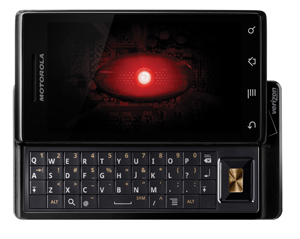Droid Preview: iPhone's first real competition has arrived


I've been a fan of Android since the G1 came out on T-Mobile on and wrote the Google Phone Pocket Guide for PeachPit Press.
Verizon is marketing Droid squarely at potential iPhone customers by promoting its features that aren't available on the venerable Apple device.
Droid's biggest advantages come courtesy of Google's Android operating system, which graduated to version 2.0 (code named Eclair). Android is maturing quickly and its open platform, background apps, widgets and customization expose many of the chinks in the iPhone's armor. When you combine Android 2 with the hardware features included in the Droid handset – including its physical keyboard, removable battery, 5MP camera and expansion slot – you have a potent one-two punch against the iPhone.
As expected, the Verizon network is its best feature. Calls are clear and I haven't had a single dropped call in my testing. My iPhone displays the "Call Failed" error at least once per day. VZW is also attempting to lure customers away from the iPhone (and AT&T) by promoting the company's superior 3G data network with its There's a map for that campaign.
While themes and widgets may seem trivial, they're a welcome upgrade over the iPhone which provides no customization options without jailbreaking the device. Mac users may be concerned about the lack of native sync software for the Mac, but luckily Google Contacts sync natively with Address Book and Google Calendar syncs with iCal.
Droid's optional haptic feedback, which provides a slight vibrating feedback as keys are pressed, is another welcome addition. Another major upgrade in Android 2.0 is the addition of Google Maps with driving directions which provides voice-assisted turn-by-turn directions based on GPS. On the iPhone GPS with directions costs extra – including a hefty monthly fee.
While a physical keyboard may seem like a good idea, I find Droid's mushy with not enough key travel. To make matters worse, it doesn't auto-correct as you type. The good news is that Android 2.0's virtual keyboard has an improved layout which improves accuracy and includes a smart dictionary that includes contact names.
The Droid is available tomorrow for $200 (after a $100 mail-in rebate) and requires a minimum $70 monthly service plan for two years – text messaging costs extra. Droid comes with a 16GB MicroSD card, expandable up to a 32GB.